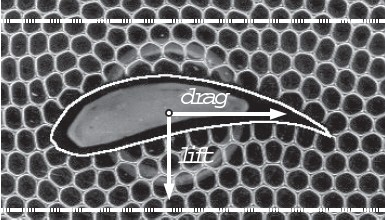The flow of air over the wings of an aeroplane provides the lift that keeps it in the air. However, physicists in France have discovered that when a foam flows over an aerofoil, the resulting force is exerted downwards rather than upwards. The force - which the team calls anti-inertial lift - could have implications in fields as diverse as oil extraction and industrial cleaning processes (Phys. Rev. Lett. 95 168303).

Benjamin Dollet and François Graner of the Laboratoire de Spectrométrie Physique (LSP) in Grenoble, and Miguel Aubouy of the CEA laboratory in Grenoble, began by filling a tank with a solution made up of 1% washing-up liquid in deionised water, and then blowing nitrogen though the solution to create a foam containing bubbles with an average thickness of 3.5 mm. Next they used a CCD camera to observe how the foam flowed around a small aerofoil-shaped object in the tank. Finally, they measured how the obstacle moved with a force sensor.
The French team found that the flow of foam slowed down beneath the obstacle and accelerated in the region above it. This produces an elastic deformation of the bubbles in the foam. To reduce this deformation, the bubbles below the wing pull the wing down. The bubbles above the wing also push it down, causing the wing to sink into the foam (see figure and movie).
“Our work reveals that complex fluids, like foams, display a completely different physical behaviour to simple fluids, like air or water,” says Dollet. “It could help us better understand, and thus predict, the behaviour of foam in a variety of situations, including flow within porous rock in oil extraction, rinsing in industrial cleaning, and ore separation in the mining industry.”
The results might also have implications for granular materials and polymers, and they might even shed light on how embryonic cells rearrange themselves in a growing foetus.



